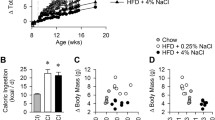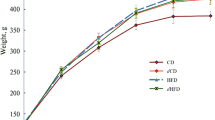Summary
In view of the common practice of dieting for weight reduction, the influence of severe food restriction (about 25% of ad libitum intake) on adrenergic mechanisms was studied. Cardiac norepinephrine and epinephrine concentrations as well as plasma norepinephrine levels, were increased upon feeding a restricted diet to rats for 14 days in comparison with control rats that ingested about 30 g food/day. Bradycardia as well as characteristic electrocardiographic abnormalities, including prolongation of the QRS and QT intervals, were observed in food-restricted rats. Dietrestricted rats did not develop ventricular arrhythmias in response to epinephrine injections as readily as control rats. Depression in both +dP/dt and-dP/dt of the heart in situ as well as reductions in the inotropic responses to epinephtine were evident in diet-restricted rats. Beta-adrenergic binding studies revealed a significant decrease in receptor density, but the dissociation constant for binding was also depressed in the food-restricted rat heart. Downregulation of the beta-adrenergic receptors in the heart may explain the lack of an epinephrine-induced increase in contractile force development as well as arrhythmias in food-restricted rats. These data demonstrate that severe food restriction has marked effects on adrenergic mechanisms and heart function, and thus some caution should be exercised at early periods of this therapy for weight reduction.
Similar content being viewed by others
References
Rappaport EB, Young JB, Landsberg L. Initiation, duration and dissipation of diet-induced changes in sympathetic nervous system activity in the rat. Metabolism 1982;31: 143–146.
Wagner JA, Reynolds IJ, Weisman HF, Deduck P, Weisfeldt ML, Synder SH. Calcium antagonist receptors in cardiomyopathic hamster: Selective increases in heart, muscle and brain. Science 1986;232:515–518.
Corr PB, Sharma JA, Kraner JB, Kipnis RJ. Increased alpha-adrenergic receptors in ischemic cat myocardium. J Clin Invest 1981;67:1232–1236.
Mukherjee C, Caron M, Coverstone M, Lefkowitz R. Identification of adenylate cyclase-coupled β-adrenergic receptors in frog erythrocytes with [3H]-alprenolol. J Biol Chem 1975;250:4869–4876.
Haxhe JJ. Experimental undernutrition I: Its effects on cardiac output. Metabolism 1967;16:1086–1091.
Scatchard G. The attractions of proteins for small molecules and ions. Ann NY Acad Sci 1949;00:660–672.
McPherson GA. A practical computer-based approach to the analysis of radioligand binding experiments. Comput Methods Program Biomed 1983;17:107–113.
Ganguly PK, Dhalla KS, Innes IR, Beamish RE, Dhalla NS. Altered norepinephrine turnover and metabolism in diabetic cardiomyopathy. Circ Res 1986;57:684–693.
Krause MV, Mahan LK. Food, Nutrition, and Diet Therapy. Philadelphia: W.B. Saunders, 1984:706–734.
Rupp H, Elimban V, Dhalla NS. Diabetes-like action of intermittent fasting on sarcoplasmic reticulum Ca2+-pump ATPase and myosin isozymes can be prevented by sucrose. Biochem Biophys Res Commun 1989;164:319–325.
Mukherjee C, Caron MG, Lefkowitz RJ. Catecholamine induced subsensitivity of adenylate cyclase associated with loss of β-adrenergic receptor binding sites. Proc Natl Acad Sci USA 1975;72:1945–1949.
Opie LH. Effect of fatty acids on contractility and rhythm of the heart. Nature 1970;227:1055–1056.
Kurien VA, Oliver MF. Serum free fatty acids after acute myocardial infarction and cerebral vascular occlusion. Lancet 1996;2:122–127.
Oliver MF, Kurien VA, Greenwood TW. Relation between serum free fatty acids and arrhythmias and death after acute myocardial infarction. Lancet 1968;1:710–714.
Kurien VA, Oliver MF. A metabolic cause for arrhythmias during acute myocardial hypoxia. Lancet 1970;1:813–815.
Normann SJ, Priest RE, Bendett EP. Electrocardiogram in the normal rat and its alteration with experimental coronary occlusion. Circ Res 1961;9:282–287.
Hurdley JM, Ashburn LL, Sebrell WH. The electrocardiogram in chronic thiamine deficiency in rats. Am J Physiol 1945;144:404–414.
Sambhi MP, White FN. The electrocardiogram of the normal and hypertensive rat. Circ Res 1960;8:129–134.
Peris J, Cunningham CL. Dissociation of tolerance to the hypothermic and tachycardic effects of ethanol. Pharmacol Biochem Behav 1985;22:973–978.
Gross M. Anorexia nervosa: An overview. Cleve Clin Q 1983;50:371–376.
Moodie DS. Anorexia and the heart; Results of studies to assess effects. Postgrad Med 1987;81:46–55.
Young JB, Landsberg L. Suppression of sympathetic nervous system during fasting. Science 1977;196:1473–1475.
Young JB, Kaufman LN, Saville ME, Landsberg L. Increased sympathetic nervous system activity in rats fed a low-protein diet. Am J Physiol 1985;248:R627-R637.
Stahl JJ, Alden PB, Madoff RD, Ring WS, Cerra FB. Cardiac β-adrenergic responsiveness is well preserved in moderate protein calorie malnutrition from semistarvation. J Parenter Enter Nut 1988;12:579–586.
Crandall DL, Lai FM, Huggins FJ. Effect of caloric restriction on cardiac reactivity and β-adrenoceptor concentration. Am J Physiol 1983;244:H444.
Benfey BG, Varma DR, Yue TL. Myocardial inotropic responses and adrenoceptors in protein deficient rats. Br J Pharmacol 1983;80:527.
Bhagat BD, Rao PS, Dhalla NS. Role of catecholamines in the genesis of arrhythmias. Adv Myocardiol 1980;2: 117–132.
Bertel O, Buhler FR, Baitsch G, Ritsz R, Burkart F. Plasma adrenaline and noradrenaline in patients with acute myocardial infarction: Relationship to ventricular arrhythmias of varying severity. Chest 1982;82:64–68.
Steiger JF, McCann DS. In vivo platelet aggregation and plasma catecholamines in acute myocardial infarction. Am Heart J 1982;104:1255–1261.
Author information
Authors and Affiliations
Rights and permissions
About this article
Cite this article
McKnight, K.A., Rupp, H., Beamish, R.E. et al. Modification of catecholamine-induced changes in heart function by food restriction in rats. Cardiovasc Drug Ther 10 (Suppl 1), 239–246 (1996). https://doi.org/10.1007/BF00120493
Received:
Accepted:
Issue Date:
DOI: https://doi.org/10.1007/BF00120493




